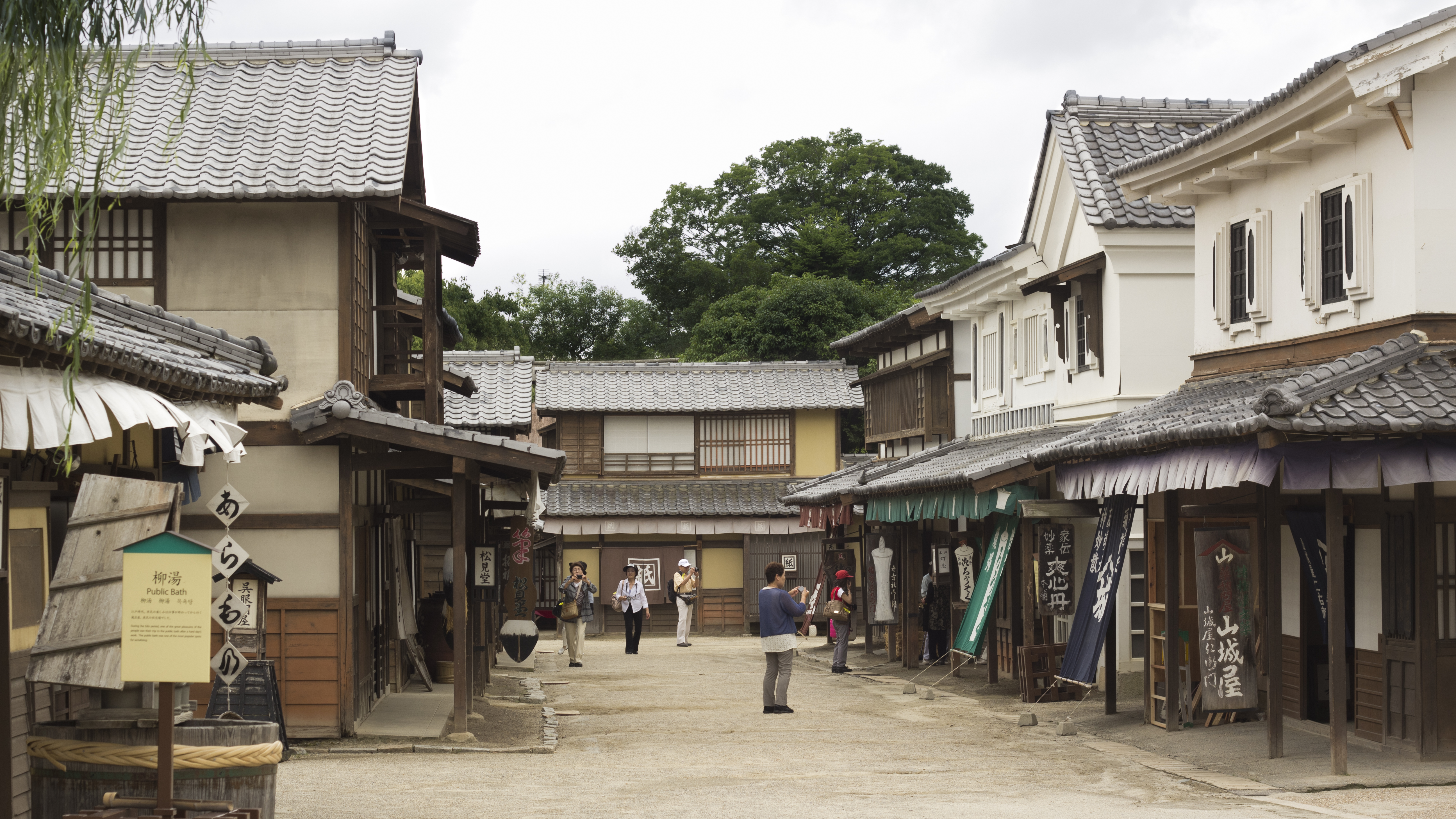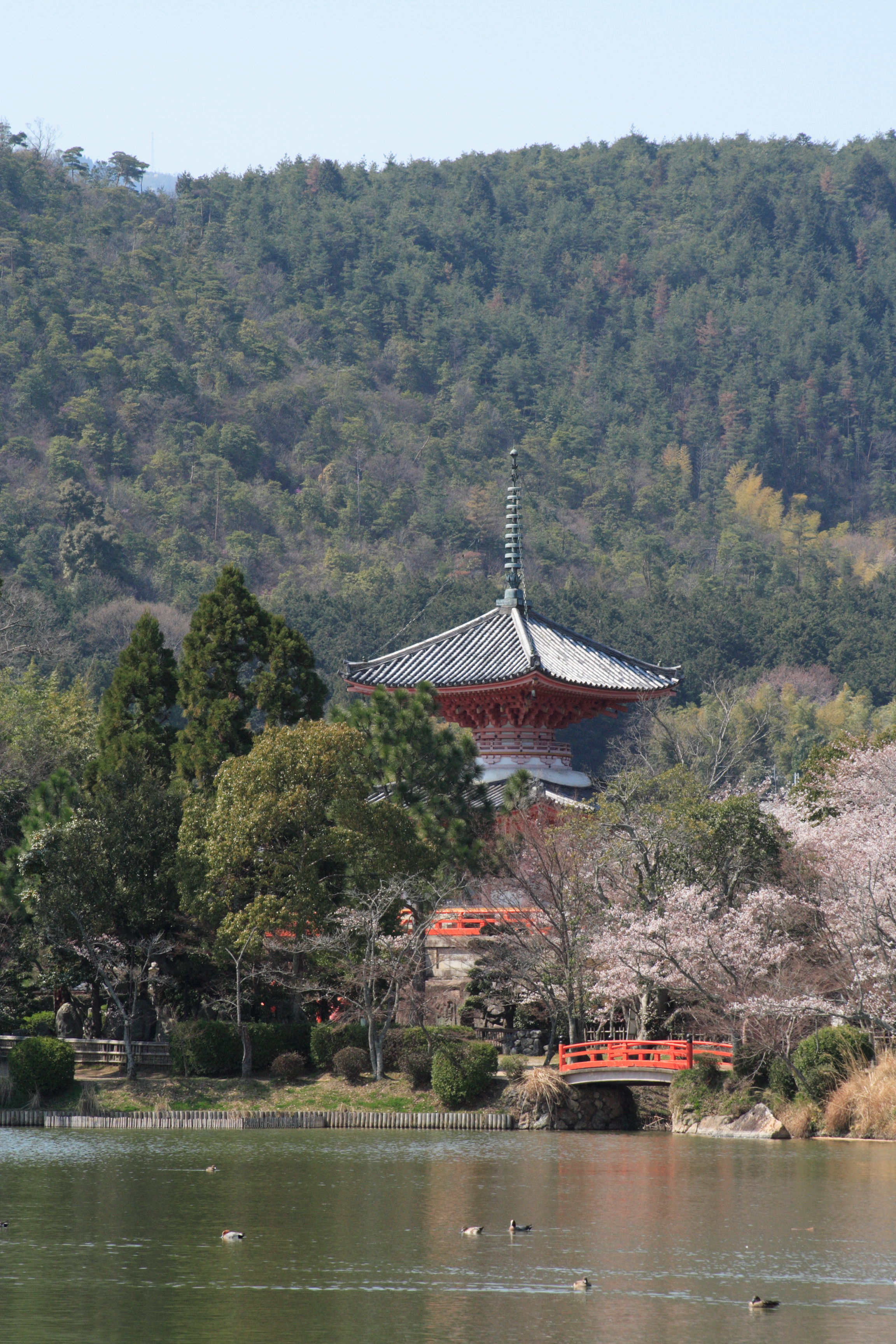|
Nijō Station (Kyoto)
is a train station in Nakagyō-ku, Kyoto, Nakagyō-ku, Kyoto, Japan. Lines * ** Sagano Line (Sanin Main Line) * ** (Station Number: T15) Layout JR West The station has one elevated island platform between two tracks. The station building was designed by Urabesekkei, an architectural firm based in Osaka. Prior to the platform elevation, the station was only accessible from the east (Sembon Street side), but the station renovation made it accessible from both the east and west sides. The design elements of the former station building were evocative of nearby Nijō Castle. The building was dismantled and rebuilt at the Kyoto Railway Museum (then called the Umekoji Steam Locomotive Museum) in 1996. Kyoto Subway Subway station has one underground island platform with two tracks, separated by platform screen doors. History Nijō Station opened on 15 February 1897 and was the terminus of the Kyoto Railway (present-day San'in Main Line) until 27 April of the same year. ... [...More Info...] [...Related Items...] OR: [Wikipedia] [Google] [Baidu] |
Nakagyō-ku, Kyoto
is one of the eleven wards in the city of Kyoto, in Kyoto Prefecture, Japan. Its name means "central capital ward." As of 2021, the ward has an estimated population of 109,629 people. Tourism, shopping, and entertainment are the primary sources of income in the area. The Kamo River flows through the district in the area known as Kawaramachi. The three most famous festivals of Kyoto, the Aoi Matsuri, the Gion Matsuri, and the Jidai Matsuri can all be seen in Nakagyō-ku. It is also home to several historical places and temples. Demographics Temples and landmarks *Nijō Castle a former residence for the Tokugawa Shogunate *Kyoto International Manga Museum *Nishiki Market *Museum of Kyoto *Kyoto Art Center Economy The ward is home to the headquarters of several companies: *Q-Games *Shimadzu, in Nishinokyo-Kuwabara-cho *Nichicon, in Karasuma-dori Oike-agaru [...More Info...] [...Related Items...] OR: [Wikipedia] [Google] [Baidu] |
Ritsumeikan University
is a private university in Kyoto, Japan, that traces its origin to 1869. With the Kinugasa Campus (KIC) in Kyoto, and Kyoto Prefecture, the university also has a satellite called Biwako-Kusatsu Campus (BKC) and Osaka-Ibaraki Campus (OIC). Today, Ritsumeikan university is known as one of western Japan's four prestige private universities. "KAN-KAN-DO-RITS" 関関同立 (Kwansei Gakuin University, Kansai University, Doshisha University, and Ritsumeikan University) is the abbreviation that refers to the four leading private universities in the region of 20 million people. Ritsumeikan University is renowned for its International Relations (IR) and Science & Engineering departments, with the Graduate School of International Relations being the only Japanese member of the Association of Professional Schools of International Affairs. Ritsumeikan University has exchange programmes with schools throughout the world, including The University of British Columbia, The University of Melbou ... [...More Info...] [...Related Items...] OR: [Wikipedia] [Google] [Baidu] |
Toei Kyoto Studio Park
is a theme park and film set modeled after the Edo period located in Kyoto, Japan that opened its doors in 1975. It is situated in Toei Company's Kyoto Studio where movies have been produced. Projects filmed at the park include Sebastiano Serafini's historical Japan-themed music video for the single "Inori". File:Toei Kyoto Studio Park.jpg File:Toei Uzumasa-0183.jpg File:Toei Uzumasa-0312.jpg File:中村座 (2681433589).jpg File:東映太秦映画村 - 映画文化館入口.jpg File:Kitamachibugyosho.jpg File:130706 Toei Kyoto Studio Park Kyoto Japan07n.jpg File:130706 Toei Kyoto Studio Park Kyoto Japan06n.jpg File:東映太秦映画村 - 史上最恐のお化け屋敷.jpg References * * * External links Toei Kyoto Studio Park Tourist attractions in Kyoto Amusement parks in Japan Toei Company {{Amusement-park-stub ... [...More Info...] [...Related Items...] OR: [Wikipedia] [Google] [Baidu] |
Daikaku-ji
is a Shingon Buddhist temple in Ukyō-ku, a western ward in the city of Kyoto, Japan. The site was originally a residence of Emperor Saga (785–842 CE), and later various emperors conducted their cloistered rule from here. The ''Saga Go-ryū'' school of ikebana has its headquarters in the temple. The artificial lake of the temple, Ōsawa Pond, is one of the oldest Japanese garden ponds to survive from the Heian period. History The origins of the temple dates back to the Heian period in the year 814 CE, when Emperor Saga had a palace, known as the ''Saga-in'', constructed on the site. The palace later became his seat of retirement, known as ''Saga Rikyu'' imperial villa. According to tradition, when Japan suffered a serious epidemic, the Buddhist monk Kobo Daishi, the founder of Shingon Buddhism, suggested that the Emperor Saga personally copy an important Buddhist religious document called the Heart Sutra (''Hannya Shingyō''). The emperor made a handwritten copy, and ... [...More Info...] [...Related Items...] OR: [Wikipedia] [Google] [Baidu] |
Kyoto Station
Kyoto (; Japanese: , ''Kyōto'' ), officially , is the capital city of Kyoto Prefecture in Japan. Located in the Kansai region on the island of Honshu, Kyoto forms a part of the Keihanshin metropolitan area along with Osaka and Kobe. , the city had a population of 1.46 million. The city is the cultural anchor of a substantially larger metropolitan area known as Greater Kyoto, a metropolitan statistical area (MSA) home to a census-estimated 3.8 million people. Kyoto is one of the oldest municipalities in Japan, having been chosen in 794 as the new seat of Japan's imperial court by Emperor Kanmu. The original city, named Heian-kyō, was arranged in accordance with traditional Chinese feng shui following the model of the ancient Chinese capital of Chang'an/Luoyang. The emperors of Japan ruled from Kyoto in the following eleven centuries until 1869. It was the scene of several key events of the Muromachi period, Sengoku period, and the Boshin War, such as the Ōnin War, the Honnō ... [...More Info...] [...Related Items...] OR: [Wikipedia] [Google] [Baidu] |
Kitano Tenman-gu
is a Japanese comedian, television presenter, actor, filmmaker, and author. While he is known primarily as a comedian and TV host in his native Japan, he is better known abroad for his work as a filmmaker and actor as well as TV host. With the exception of his works as a film director, he is commonly known by the stage name . Kitano rose to prominence in the 1970s as one half of the comedy duo ''Two Beat'', before going solo and becoming one of the three biggest comedians in the country. After several small acting roles, he made his directorial debut with 1989's '' Violent Cop'' and garnered international acclaim for '' Sonatine'' (1993). He was not widely accepted as an accomplished director in Japan until ''Hana-bi'' won the Golden Lion in 1997. In October 2017, Kitano completed his ''Outrage'' crime trilogy with the release of ''Outrage Coda''. He is also known internationally for hosting the game show ''Takeshi's Castle'' (1986–1990) and starring in the film '' Battle Ro ... [...More Info...] [...Related Items...] OR: [Wikipedia] [Google] [Baidu] |
Kamigamo Shrine
is an important Shinto sanctuary on the banks of the Kamo River in north Kyoto, first founded in 678. Its formal name is the . It is one of the oldest Shinto shrines in Japan and is one of the seventeen Historic Monuments of Ancient Kyoto which have been designated by UNESCO as a World Heritage Site. The term Kamo-''jinja'' in Japanese is a general reference to Shimogamo Shrine and Kamigamo Shrine, the traditionally linked Kamo shrines of Kyoto. The Kamo''-jinja'' serve the function of protecting Kyoto from malign influences. The ''jinja'' name identifies the Kamo family of ''kami'' or deities who are venerated. The name also refers to the ambit of shrine's nearby woods, which are vestiges of the primeval forest of Tadasu no Mori. In addition, the shrine name references the area's early inhabitants, the Kamo clan, many of whom continue to live near the shrine their ancestors traditionally served. Kamogamo Shrine is dedicated to the veneration of Kamo Wake-ikazuchi, the ''kami ... [...More Info...] [...Related Items...] OR: [Wikipedia] [Google] [Baidu] |
Heian Shrine
The is a Shinto shrine located in Sakyō-ku, Kyoto, Japan. The Shrine is ranked as a ''Beppyō Jinja'' () (the top rank for shrines) by the Association of Shinto Shrines. It is listed as an important cultural property of Japan. History 220px, Lake at Heian Shrine In 1895, a partial reproduction of the Heian Palace from Heian-kyō (the former name of Kyoto) was planned for construction for the 1100th anniversary of the establishment of Heian-kyō. The Industrial exposition fair (an exhibition of development of Japanese and foreign cultures) was held in Kyoto that year, where the replica was to be the main monument. However, failure to buy enough land where the Heian Palace used to stand, the building was built in Okazaki at 5/8 scale of the original. The ''Heian-jingū'' was built according to designs by Itō Chūta. After the Exhibition ended, the building was kept as a shrine in memory of the 50th Emperor, Emperor Kanmu, who was the Emperor when Heian-kyō became the capit ... [...More Info...] [...Related Items...] OR: [Wikipedia] [Google] [Baidu] |
Oike Street
Oike Street (御池通 おいけどおり ''Oike Dōri'') is a mayor street that crosses the center of the city of Kyoto from east to west, running approximately 4.9 km from Kawabata Street (east) to Tenjingawa Street (west). History During the period of the Heian-kyō, it was a narrow street known as Sanjō Bonmon Koji (三条坊門小路). From the mid Edo period the street began to be known as ''Oike'', due to the fact that in the past it passed by a large pond (池 ''ike'') contained inside the then larger Shinsenen. In 1945 during World War II, WW2, in the section between the west side of the Kamo River and Horikawa, Kyoto, Horikawa Street, houses and buildings were removed to create a firewall, making the street considerably wider. After 1947, due to the urban planning policy of the city, it was decided to maintain a width of 50 meters for this section. Present Day Nowadays the section between Kawabata Street and Horikawa Street is the widest street in the city of ... [...More Info...] [...Related Items...] OR: [Wikipedia] [Google] [Baidu] |
Kansai International Airport
Kansai International Airport ( ja, 関西国際空港, Kansai Kokusai Kūkō) commonly known as is the primary international airport in the Greater Osaka Area of Japan and the closest international airport to the cities of Osaka, Kyoto, and Kobe. It is located on an artificial island () in the middle of Osaka Bay off the Honshu shore, southwest of Ōsaka Station, located within three municipalities, including Izumisano (north),Home . Kansai Airport. Retrieved on 23 July 2011. "Hotel Nikko Kansai Airport 1, Senshu-kuko Kita, Izumisano-shi, Osaka, 549-0001, Japan " Sennan (south), [...More Info...] [...Related Items...] OR: [Wikipedia] [Google] [Baidu] |





